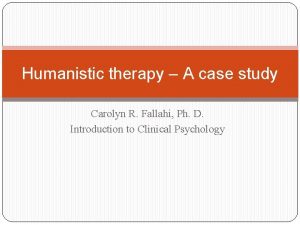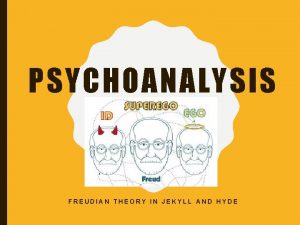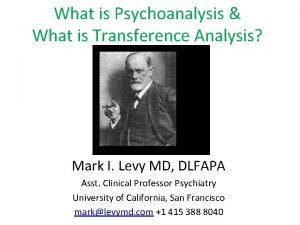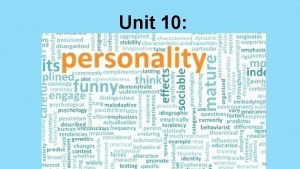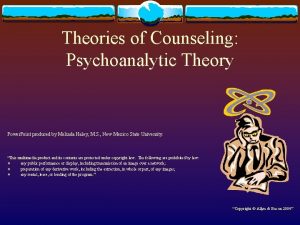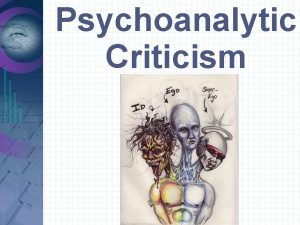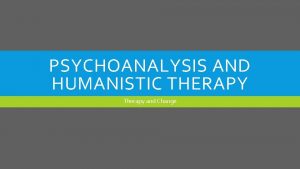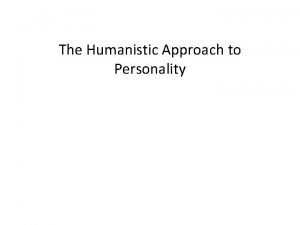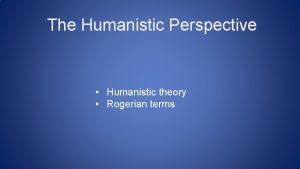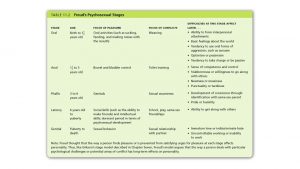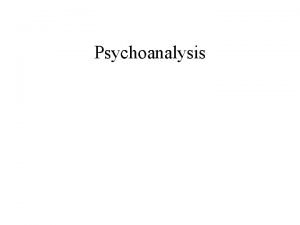17 2 Psychoanalysis and Humanistic Therapy La Tesha












- Slides: 12

17 -2 Psychoanalysis and Humanistic Therapy. La. Tesha Powell Sarah Lin Trump Eddie Mobley Isaac Matthews Oja’Nique Goodson Robert Jones

What is Psychoanalysis? • Based on theories of Sigmund Freud. • He believed that psychological problems are caused by the anxiety of hidden conflicts. • Treat patients by making them aware of unconscious impulses, desires, and fears. • Insight – Gaining knowledge of the unconscious as a way to treat psychological problems. • Slow process (may take years). • People with loss of contact with reality will probably not benefit from this treatment.

Free Association • Typically what we would think of as a patient laying on a couch and therapist sitting in a chair taking notes. • Therapist instructs patient to relax and talk about what is on their mind. • Express all thoughts, even the embarrassing or ones that feel unimportant. • Therapist sits quietly and listens, may guide the patient gently. • Resistance – any behavior that stands in the way of therapy.


Dream Analysis • Interpreting dreams for patterns or information about the patient’s mental state. • Manifest content – What you remember about dream. • Latent content – Hidden meanings that are represented with symbols to be interpreted by the psychoanalyst. • There is little research to back up the claim that this method is effective.


Transference • A patient begins to treat therapist the way that he/she feels about another person in their life (usually a parent). i. e. “I hate you for leaving me behind. ” • Therapists do not allow this behavior and always direct the conversation back to the patient. • True feelings come out in the raw and awareness of these feelings leads to recovery. • The patient begins to understand why they feel a certain way and how this is affecting their life subconsciously.


Client-Centered Therapy • Humanistic therapy - Help people fulfill their human potential. • Client-Centered Therapy is based on theories of Carl Rogers. • Patient’s own motivation for growth and self-actualization fuels therapy. • Assumes that people are basically good, psychological disturbances occur when the ‘true self’ is lost. • Say ‘person’ or ‘client’ instead of ‘patient’.

Techniques of Client-Centered Therapy • When the client is asked to speak, the topic for discussion are up to them. This is nondirective therapy because therapist does not direct it. • Active listening is when therapist tries to echo back the words of the client to him/her. • Unconditional positive regard means that the atmosphere of the sessions should be all-encouraging and open. • No fear of disapproval, shame, embarrassment, or other negativity.

Relationship Psychoanalysis • Relational psychoanalysis combines interpersonal psychoanalysis with object-relations theory. • Relational psychoanalysis emphasizes how the individual's personality is shaped by both real and imagined relationships with others, and how these relationship patterns are reenacted in the interactions between analyst and patient. • Relational Psychoanalysis began in the 1980’s. • Relationalists say that personality comes from early relationships with parents and other figures that were involved in their lives. • Relationalists use recreation of relational patterns serve to as a way to conform with what they learned as infants.

The End!
 Psychodynamic and humanistic therapies have in common
Psychodynamic and humanistic therapies have in common Humanistic therapies aim to boost
Humanistic therapies aim to boost Humanistic approach case study
Humanistic approach case study Unit 13 ap psychology
Unit 13 ap psychology Free association humanistic
Free association humanistic Therapies defined as “talk therapies” include
Therapies defined as “talk therapies” include Freud and jekyll and hyde
Freud and jekyll and hyde Freudian fixation
Freudian fixation Analysis of transference in psychoanalysis
Analysis of transference in psychoanalysis Freudian fixation
Freudian fixation Psychoanalysis
Psychoanalysis Psychoanalytic criticism definition
Psychoanalytic criticism definition Eros freud
Eros freud


